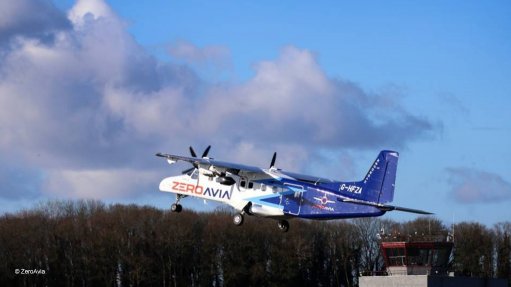
ZeroAvia’s modified Dornier D 228 takes off on its first flight with a hybrid-electric powertrain, in January
Photo by: ZeroAvia
UK-US zero-emission aviation technology company ZeroAvia has posted, on social media platform Facebook, that its 19-seat Dornier Do 228 testbed aircraft had flown, in level flight, using only its hydrogen-electric power train. This was noted and reported by renowned UK aerospace website “FlightGlobal” (an outlet of weekly journal Flight International). The test flight had taken place at Cotswold Airport in England, in the UK.
ZeroAvia’s Do 228 has been modified by having one of its two Honeywell TPE-331 turboprop engines replaced by the company’s 600 kW hydrogen-electric power unit, which is designated ZA-600. The conventional engine is on the aircraft’s starboard (right) wing while the ZA-600 is on its port (left) wing.
According to ZeroAvia’s Facebook post, the Do 228 “flew with zero thrust from the conventional turbine engine as the ZA-600 entirely powered the testbed aircraft as it circled Costwold Airport. The flightcrew were able to perform tests to confirm the aircraft was able to fly on hydrogen-electric power with the turbine throttled back to simulate a zero thrust.”
The ZA-600 powertrain is composed of two fuel cell stacks, coupled with lithium-ion battery packs (to support peak power demand during take-off as well as to increase redundancy for safe testing). Fuel for the powertrain is compressed gaseous hydrogen, provided by programme partner the European Marine Energy Centre, through the Hydrogen Airport Refuelling Ecosystem that it installed and operated at the airport. On the testbed Do 228, the fuel cells and hydrogen tanks are fitted inside the cabin. In production configuration, powering commercial aircraft, they would be mounted externally on the airframe.
“FlightGlobal” noted that the Facebook post did not say if the aircraft had drawn power from the battery packs during the level flight phase using zero turbine power. These battery packs had provided some 50% of the power for the electric motor on the testbed’s first flight in January.
This flight was the aircraft’s third test flight. The first had been on January 19 and the second on February 1. ZeroAvia attributed the slow flight test tempo (and the gap of nearly two months between the second and third flights) to bad weather. It stated that, as the weather improved (with the northern spring) the frequency of test flights would increase.
ZeroAvia sees fuel cells as the only practical option to achieve true zero-emissions aviation. Hydrogen combustion would eliminate carbon dioxide emissions but could still produce nitrous oxide emissions, and nitrous oxide was very definitely a greenhouse gas.
The ZA-600 is intended to power 9-seat to 19-seat passenger aircraft, providing a range of 483 km. The company is aiming to achieve certification, and start production and deliveries of the powertrains, in 2025.